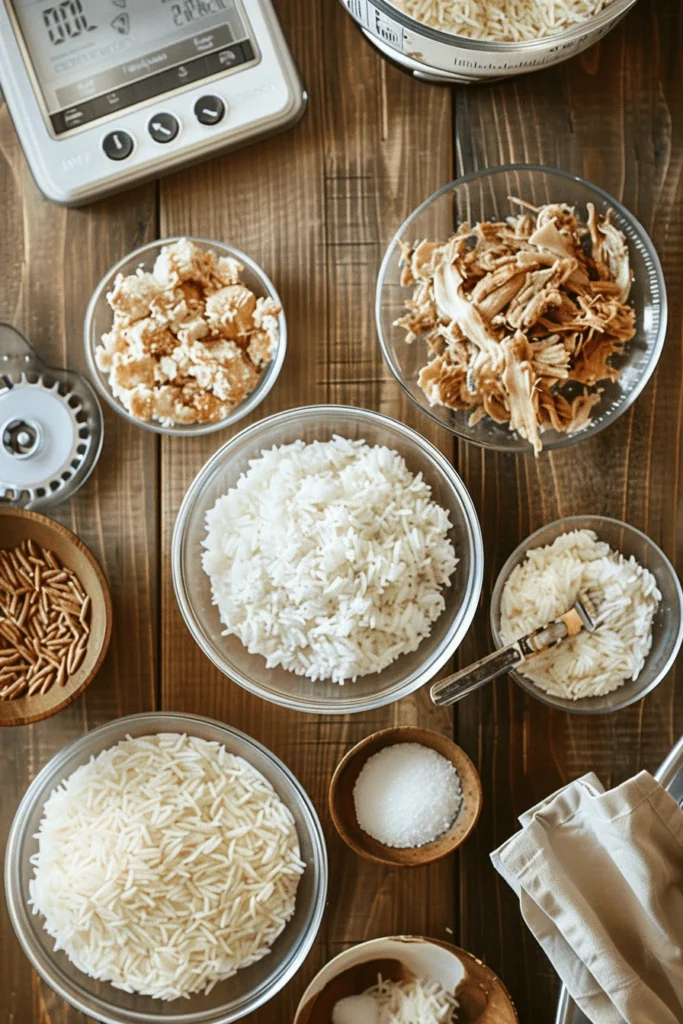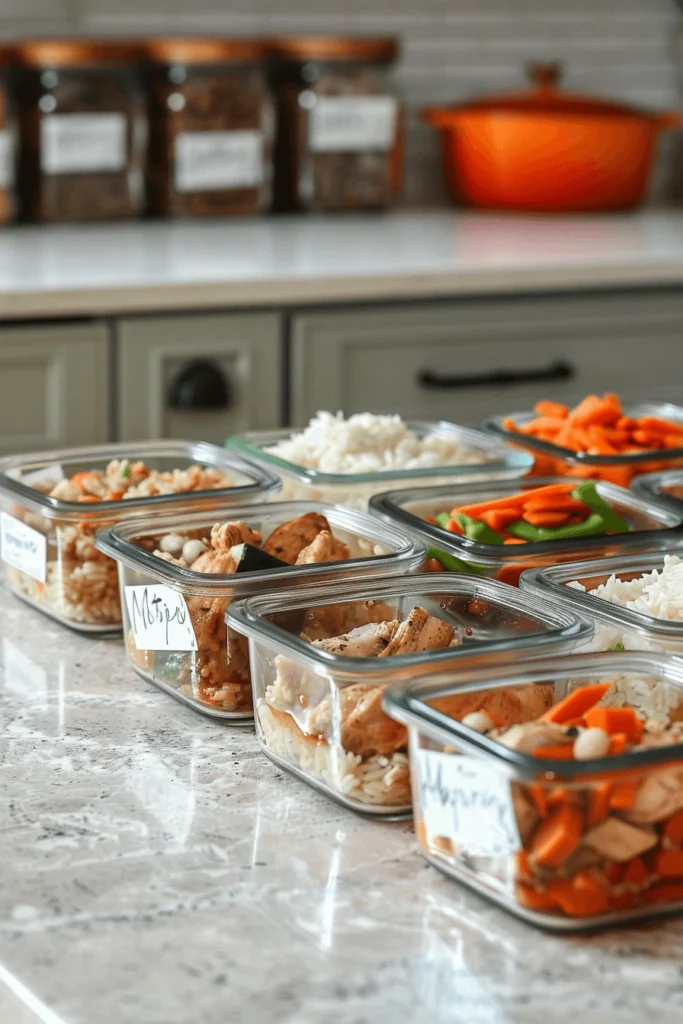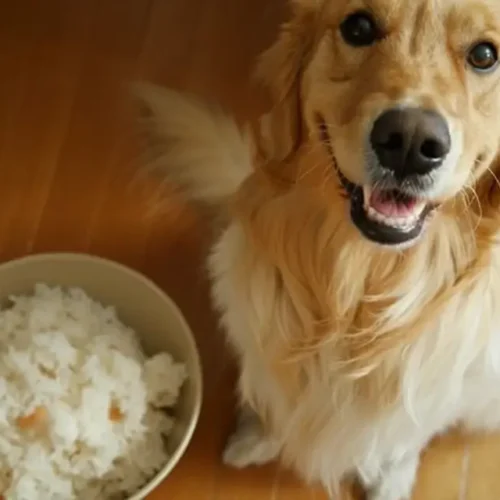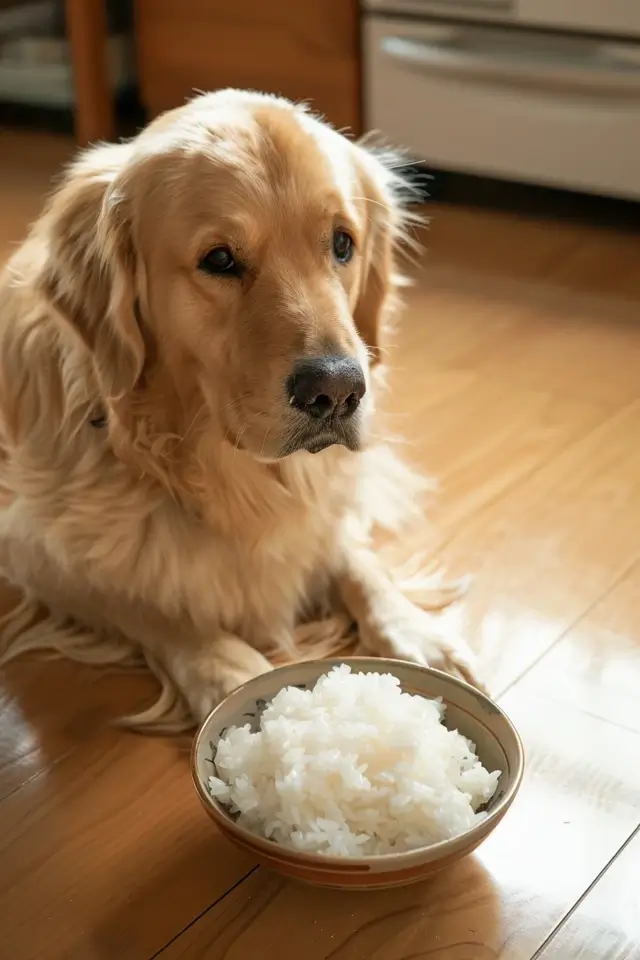When your furry friend isn’t feeling their best—maybe they’re dealing with an upset stomach, diarrhea, or just recovering from illness—you want to do everything possible to help them heal gently and safely. That’s where a bland diet for dogs comes in. It’s simple, soothing, and nourishing for sensitive tummies. But one of the most common questions we hear from caring dog parents is: “bland diet for dogs how much to feed? “
In this guide, we’ll walk you through everything you need to know. You’ll learn when and why to use a bland diet, the best ingredients to use, and exactly how much to feed your dog based on their weight and condition. We’ll also share sample menus, feeding schedules, and trusted tips to keep your pup healthy and happy.
Table of Contents
Common Ingredients in a bland diet for dogs how much to feed
Chicken and Rice: The Most Trusted Combo
When it comes to easing a dog’s digestive issues, boiled chicken and white rice is the gold standard. It’s gentle, effective, and widely recommended by vets.
Here’s why this combo works so well:
- Boiled chicken (skinless and boneless) is lean and packed with easily digestible protein to help your dog maintain strength during recovery.
- White rice is soft, low in fiber, and calming to the digestive system.
Tip: Use white rice instead of brown rice—brown rice is harder to digest and can be too fibrous for sensitive stomachs.
How to Prepare Chicken and Rice:
- Boil the chicken thoroughly in plain water. No salt, oil, or seasoning.
- Cook white rice separately until soft.
- Combine at a 2:1 ratio of rice to chicken (more carbs, fewer proteins is easier to digest).
- Let the mixture cool completely before serving.
Portion tip: Use the feeding guide in Part 3 to know how much chicken and rice to give your dog based on their body weight.
Discover great ideas like our DIY chicken and rice bland meal plan designed for upset stomach relief.
Beef and Rice: When to Use and How to Prepare It
Sometimes, dogs may not tolerate chicken or simply prefer variety. In that case, lean ground beef is a great alternative. Just like chicken, it’s a bland protein source when prepared correctly.
Choose 90% lean beef or leaner to reduce fat content and ease digestion.
How to Prepare Beef and Rice:
- Boil or brown the beef in a non-stick pan—drain off all fat and rinse it with hot water if needed.
- Cook white rice separately.
- Mix beef and rice at the same 2:1 ratio (rice to beef) for the best balance.
- Let cool before serving.
Nutritional Tip: Beef offers more fat than chicken, which is fine for active dogs, but for sensitive tummies, monitor closely.
Portion Guidelines by Dog’s Weight

Feeding your dog the right amount of food on a bland diet is just as important as choosing the right ingredients. Overfeeding can prolong tummy troubles, and underfeeding might leave your pup without enough energy to heal.
So, how much should you feed? Let’s break it down by dog weight, using chicken and rice or beef and rice as the standard bland meals.
Reminder: Always consult your vet for personalized advice if your dog has medical conditions or is on medication.
How Much Chicken and Rice to Feed by Weight
Here’s a helpful table with daily feeding guidelines based on your dog’s weight. These are total daily amounts and should be divided into 3–4 small meals throughout the day.
| Dog Weight (lbs) | Total Daily Amount (cups) | Chicken (⅓) + Rice (⅔) |
|---|---|---|
| 5–10 lbs | ½ – 1 cup | ⅓ cup rice + ⅙ cup chicken |
| 11–20 lbs | 1 – 1½ cups | 1 cup rice + ½ cup chicken |
| 21–40 lbs | 1½ – 3 cups | 2 cups rice + 1 cup chicken |
| 41–60 lbs | 3 – 4 cups | 2½ cups rice + 1¼ cups chicken |
| 61–80 lbs | 4 – 5 cups | 3⅓ cups rice + 1⅔ cups chicken |
| 81–100+ lbs | 5 – 6 cups | 4 cups rice + 2 cups chicken |
Don’t forget to watch your dog’s weight and stool consistency. If your pup is gaining or losing weight quickly, adjust the portion slightly.
How Much Beef and Rice to Feed by Weight
Beef tends to be more calorie-dense than chicken, so you may need slightly smaller portions. Here’s a modified guideline:
| Dog Weight (lbs) | Total Daily Amount (cups) | Beef (⅓) + Rice (⅔) |
|---|---|---|
| 5–10 lbs | ½ – ¾ cup | ¼ cup rice + ⅛ cup beef |
| 11–20 lbs | ¾ – 1¼ cups | ¾ cup rice + ⅜ cup beef |
| 21–40 lbs | 1¼ – 2½ cups | 1⅔ cups rice + ¾ cup beef |
| 41–60 lbs | 2½ – 3¾ cups | 2½ cups rice + 1¼ cups beef |
| 61–80 lbs | 3¾ – 4½ cups | 3 cups rice + 1½ cups beef |
| 81–100+ lbs | 4½ – 5½ cups | 3⅔ cups rice + 1¾ cups beef |
Tip: Watch your dog’s energy levels. If your dog becomes lethargic, they may need more protein or calories.
Sample Menus and Easy Recipes

Feeding your dog a bland diet doesn’t mean serving the same boring bowl every time. With just a few simple ingredients, you can create nourishing, vet-approved meals your dog will actually enjoy. Below are sample menus and homemade recipes to get you started—with proper portions and tips to make mealtime stress-free.
3-Day Sample Menu for Bland Diet (with Quantities)
Here’s a sample bland meal plan based on a 20-pound dog needing approximately 1½ to 2 cups of food daily, divided into 3–4 meals per day.
Day 1 – Chicken and Rice
| Meal | Ingredients | Quantity |
|---|---|---|
| AM | Boiled white rice | ½ cup |
| AM | Boiled, shredded chicken | ¼ cup |
| PM | Boiled white rice | ½ cup |
| PM | Boiled, shredded chicken | ¼ cup |
Add 1–2 tsp plain pumpkin puree (not pie filling) to help with stool firmness.
Day 2 – Ground Beef and Rice
| Meal | Ingredients | Quantity |
|---|---|---|
| AM | Cooked white rice | ½ cup |
| AM | Boiled ground beef (90%) | ¼ cup |
| PM | Cooked white rice | ½ cup |
| PM | Boiled ground beef | ¼ cup |
Nutritional Tip: Drain all visible fat from the beef and rinse with warm water to reduce grease.
Day 3 – Chicken & Potato Mash
| Meal | Ingredients | Quantity |
|---|---|---|
| AM | Plain mashed potato | ½ cup (no butter!) |
| AM | Boiled chicken | ¼ cup |
| PM | Plain mashed potato | ½ cup |
| PM | Boiled chicken | ¼ cup |
Add a spoon of cooled rice water for hydration and gut relief.
Looking for inspiration? Try our vet-tested 3-day bland diet plan for upset stomach.
Simple Homemade Bland Diet Recipes (Chicken & Beef Versions)
These recipes follow the 2:1 rice-to-protein ratio, are easy to prepare, and use natural ingredients with no seasoning, dairy, or oils.
Recipe 1: Chicken & Rice Recovery Meal
Ingredients:
- 2 cups cooked white rice
- 1 cup boiled, shredded chicken
- 1 tsp plain pumpkin puree (optional)
Instructions:
- Boil chicken in water until fully cooked. Shred into small pieces.
- Cook rice separately until soft.
- Mix rice and chicken in a 2:1 ratio.
- Cool before serving. Store leftovers in the fridge for up to 3 days.
Serves: Enough for 2–3 meals for a 20–25 lb dog.
Recipe 2: Lean Beef & Rice Bland Bowl
Ingredients:
- 2 cups white rice
- 1 cup lean ground beef (90% lean or better)
- 1 tsp plain canned pumpkin or plain mashed carrot
Instructions:
- Brown ground beef in a non-stick skillet without oil. Drain fat and rinse beef in hot water.
- Cook white rice separately.
- Mix well. Let cool before serving.
Optional Boost: Add a bit of unsweetened applesauce (¼ tsp) for flavor variety.
Nutritional Considerations and Vet Advice
While bland diets are a powerful tool for short-term digestive healing, they’re not nutritionally complete for long-term feeding. In this section, we’ll guide you through important nutritional considerations and when it’s best to involve your veterinarian.
Nutritional Tips While Feeding a Bland Diet
A bland diet for dogs should be simple but effective—enough to give your dog energy and support gentle digestion while the gut heals.
But there are a few things to watch for nutritionally:
1. Short-term Use Only
Bland diets are low in essential nutrients, especially:
- Calcium and phosphorus
- Vitamins A, D, E, and K
- Omega fatty acids
- Trace minerals like zinc and copper
Tip: Stick to 3–5 days on a bland diet unless your vet recommends longer.
2. Hydration Is Key
Dogs with diarrhea or vomiting lose fluids fast. Always make sure your dog has access to fresh water, and consider offering:
- Rice water (leftover from boiling rice)
- Unseasoned chicken broth (low-sodium)
- Ice chips for dogs reluctant to drink
3. Avoid Additives
Never add the following to a bland diet:
- Salt
- Pepper or spices
- Garlic or onion
- Butter or oils
- Seasoning blends
These ingredients can worsen digestive issues or be toxic to dogs.
When to Call the Vet: Red Flags During Recovery
Most dogs respond well to a bland diet in a few days, but some symptoms are too serious to manage at home.
Contact your vet immediately if:
- Your dog refuses to eat for more than 24 hours
- Vomiting continues after 24–48 hours on the bland diet
- Diarrhea persists beyond 3 days
- You see blood in stool or vomit
- Signs of dehydration (dry gums, lethargy, sunken eyes)
Vet Tip: Puppies, senior dogs, and dogs with existing health conditions should always be seen by a vet before starting any diet change.
Mistakes to Avoid While Feeding a Bland Diet
Even the most loving dog owners can unintentionally make a few missteps when preparing or serving a bland diet for dogs. Knowing what not to do is just as important as following the best practices.
Here are the most common mistakes—and how to avoid them.
Overfeeding or Underfeeding
Mistake: Not adjusting food quantity based on your dog’s size and needs.
- Why it matters: Overfeeding can lead to further digestive upset, while underfeeding can delay recovery and cause fatigue.
Solution: Refer to Part 3 of this guide for a feeding chart based on weight. Always divide meals evenly throughout the day and monitor your dog’s appetite and stool consistency.
Using the Wrong Ingredients or Seasonings
Mistake: Adding salt, spices, oil, or butter to “make it tasty.”
- Why it matters: Dogs recovering from digestive issues need bland, unseasoned food. Even a small amount of garlic or onion powder can be toxic.
Solution: Stick to plain boiled proteins (chicken or lean beef) and white rice or mashed potatoes with no flavorings. Plain canned pumpkin or unsweetened applesauce can be used sparingly for flavor and digestion support.
Switching Back to Regular Food Too Fast
Mistake: Going from bland diet to normal food overnight.
- Why it matters: A sudden transition can cause a relapse of diarrhea or vomiting.
Solution: Follow the 3 to 5-day transition plan in Part 6, gradually reintroducing your dog’s regular food to avoid stress on the digestive system.
Ignoring Symptoms That Worsen
Mistake: Continuing the bland diet for too long without improvement.
- Why it matters: Bland diets are not nutritionally complete. If your dog’s symptoms persist, there may be an underlying health issue.
Solution: If your dog shows no improvement within 2–3 days, or if new symptoms appear, call your vet immediately.
FAQ: bland diet for dogs how much to feed
These are the top questions people ask when trying to figure out bland diet for dogs how much to feed and how to do it correctly.
Q1: How much should you feed a dog on a bland diet?
This depends on your dog’s weight, age, and energy level. A good general guideline is to feed about 1 to 1.5 cups of bland food per 20 pounds of body weight per day, divided into 3–4 meals.
Example: A 40-lb dog would eat 2 to 3 cups total per day—split into ¾ cup per meal, 3–4 times a day.
Always monitor your dog’s appetite, stool quality, and energy. If unsure, consult your vet for a custom portion plan.
Q2: How much chicken and rice should you feed your dog?
Use a 2:1 ratio of white rice to chicken. For every 1½ cups of total food, give:
- 1 cup rice
- ½ cup boiled chicken (shredded, skinless, boneless)
This ratio offers more digestible carbs, which are easier on the stomach during recovery.
Q3: How much beef and rice for a dog by weight?
Similar to chicken and rice, use a 2:1 rice to beef ratio, but adjust for beef’s higher fat content:
- A 20-lb dog needs about 1½–2 cups total per day:
- 1 to 1¼ cups rice
- ½ to ¾ cup lean ground beef (cooked, drained)
Avoid overfeeding fatty beef, and always rinse it after cooking.
Q4: How do you measure a bland diet for a dog?
Use standard measuring cups after cooking the ingredients. Don’t eyeball it. For each meal:
- Divide the daily total by the number of feedings.
- Use a ⅓ protein to ⅔ carb mix.
- Feed 3–4 small meals daily.
Bonus Tip: Use a digital scale if your dog is on a strict vet-supervised diet plan.
Q5: What is the right amount to feed a dog?
The right amount is based on:
- Body weight
- Age
- Activity level
- Health condition
Use our feeding tables in Part 3 for chicken and beef guidelines. And always observe stool consistency and energy to make small adjustments.
Q6: What is the menu for a bland diet?
A bland diet includes:
- Boiled, skinless chicken or lean ground beef
- White rice or plain mashed potatoes (no dairy)
- Optional: Plain canned pumpkin, carrot puree, or applesauce
Stick to the same simple menu for 3–5 days, then begin transitioning back to normal food gradually.
Conclusion
Feeding a bland diet to your dog can feel overwhelming at first—but with the right information, love, and guidance, it becomes a deeply nurturing step in their healing journey. From portioning the right amount of chicken and rice or beef and rice, to setting a gentle feeding schedule, to watching for signs of improvement—every detail matters when your dog isn’t feeling their best.
At Home Dog Recipes, we believe in simple, homemade, and natural solutions for your dog’s well-being. The next time your pup has a tummy issue, you’ll know exactly how much to feed, how often, and what to watch for—all while providing the kind of thoughtful, loving care that every dog deserves.

Bland diet for dogs how much to feed
Ingredients
2 cups cooked white rice (no salt or oil)
1 cup boiled, shredded chicken (skinless and boneless)
1 tsp plain canned pumpkin (optional)
Instructions
- Boil the chicken in plain water until fully cooked.
- Shred the chicken into bite-sized pieces.
- Cook white rice separately until soft and fluffy.
- Combine rice and chicken in a 2:1 ratio (more rice than chicken).
- Let the food cool completely before serving.
- Optionally, add 1 tsp of plain pumpkin puree to help with digestion.
- Serve ½–1 cup per meal, depending on your dog’s weight and vet advice.
Notes
- Use only white rice, not brown.
- Do not season with salt, garlic, onions, or oil.
- Store leftovers in an airtight container in the fridge for up to 3 days.
- Always consult your vet if symptoms persist or worsen.

1 thought on “bland diet for dogs how much to feed (2025 Ultimate Guide)”